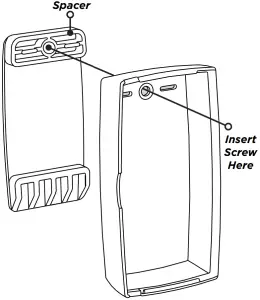INSTALLATION GUIDE
GET STARTED
The 1142 Series are wireless two-button hold-up transmitters that can be mounted under a counter or on a wall. They provide a tamper switch to identify if the unit has been removed from its mounted location. The 1142E features 128-bit AES encryption.
The 1142BC wireless two-button panic transmitter is designed to clip to a belt or pocket. Optionally, the 1142BC can be mounted under the counter or on a wall.
Both 1142 Series units provide two buttons that, when pressed at the same time, send a panic message to the control panel. They also provide an LED that can be programmed to provide visual indication that a panic alarm has been transmitted.
What’s Included
- One 1142 Wireless Two-Button Transmitter
- One 3.0V Lithium CR123A Battery
- Hardware Pack
- Belt Clip (If 1142BC was ordered)
Compatibility
- All DMP 1100 Series Wireless Receivers
- All DMP XT Series and XR Series panels
Note: To enable encryption on 1142E models, Version 183 is required for XT and XR Series panels and Version 300 is required for Wireless Receivers.
INSTALLATION
1 Program the Panel
Refer to the panel programming guide as needed.
- At a keypad, enter 6653 (PROG) to access the Programmer Menu.
Note: Steps 2 and 3 are for the 1142E to enable encryption. If using an 1142, proceed to step 4 to continue the installation.
- (1142E only) Navigate to System Options. At the 1100 ENCRYPTION prompt, select ALL to only add encrypted wireless devices to the system. Select BOTH to allow both encyrpted and non-encrypted wireless devices to be programmed.
- (1142E only) The default passphrase appears at the ENTER PASSPHRASE prompt. Press CMD to keep the default. Press any select key or area to change the passphrase and enter an 8-character hexidecimal string (0-9, A-F).
- In ZONE INFORMATION, enter the wireless ZONE NO.
- Enter the ZONE NAME.
- Select PN (panic) as the ZONE TYPE.
- At NEXT ZN?, select NO.
- At WIRELESS, select YES.
- Enter the eight-digit SERIAL# and press CMD.
- Enter the SUPRVSN TIME (supervision time) and press CMD.
Note: For the 1142BC applications where the transmitter may be taken off-site, set the supervision time to zero (0).
- At LED OPER (operation), select YES to activate or NO not to activate the LED when a panic signal is transmitted or acknowledged by the receiver. The LED pulses for five minutes after the acknowledgement is received from the panel.
- At NEXT ZN?, select YES if you are finished programming the zone. Select NO if you would like to access additional programming options.
2 Open the Transmitter
Because of the strength and the snap-on design of the plastic, the 1142 can only be opened by using a 3/16 in. slotted tip screwdriver.
- Insert the screwdriver in Tab 1 and twist it clockwise as seen in Figure 2.
- Insert the screwdriver in Tab 2 and twist it counterclockwise until the housing completely opens.

3 Install the Battery
Use a 3.0V lithium battery or a DMP Model CR123A battery. It is recommended for UL installations to use either an Energizer 123 battery or a CR123A battery manufactured by Panasonic or Tekcell. Keep in mind, when setting up a wireless system, program zones and connect the receiver (if needed) before installing the battery.
With the 1142 already open, observe polarity and place the battery in the holder and press it into place.
4 Select a Location
The 1142 Series Wireless Two-Button Transmitter provides a Survey LED capability to allow one person to confirm communication with the wireless receiver or panel while the cover is removed.
1. Hold the transmitter in the exact desired location.2. Press the tamper switch to send data to the panel and determine if communication is confirmed or faulty.
![]() Confirmed: If communication is confirmed, for each press or release of the tamper switch the LED blinks immediately on and immediately off. Repeat this test to confirm five separate consecutive LED blinks. Any indication otherwise means proper communication has not been established.
Confirmed: If communication is confirmed, for each press or release of the tamper switch the LED blinks immediately on and immediately off. Repeat this test to confirm five separate consecutive LED blinks. Any indication otherwise means proper communication has not been established.
![]() Faulty: If communication is faulty, the LED remains on for about 8 seconds or flashes multiple times in quick succession. Relocate the transmitter or receiver until the LED confirms clear communication.
Faulty: If communication is faulty, the LED remains on for about 8 seconds or flashes multiple times in quick succession. Relocate the transmitter or receiver until the LED confirms clear communication.
3. Relocate the 1142 or receiver until the LED confirms clear communication. Proper communication between the 1142 and panel is verified when for each press or release of the tamper switch, the LED blinks immediately on and immediately off.

5 Install the Transmitter
For a permanent installation, mount the 1142 in a location that is accessible but not visible to the attacking party. If you programmed the 1142 with zero (0) supervision time, go to Install the Belt Clip.
Under-the-Counter Mounting
- Set aside the top housing containing the PCB and the battery.
- Place the base housing in the desired location with the LED cut–out facing you.
- Use the two supplied Phillips screws to mount the base.
- Align the top housing and LED cut–out with the base housing and LED cut–out and snap into place. Ensure the tamper in the top housing is aligned with the tamper location on the base housing.

Note: For UL listed holdup installations, mount the 1142 in a permanent location.
Install the Belt Clip
- Set aside the top housing containing the PCB, battery, and LED.
- Align the belt clip spacer with the housing indention.
- Using the supplied screw, secure the belt clip to the housing.
- Align the top housing and LED cut out with the base housing and LED cut out and snap into place.

Use the 1142BCOnce the belt clip has been installed and the 1142BC housing is secured, clip the 1142BC to a belt or pocket that is easy to access when an emergency occurs.
6 Test the Transmitter
After the 1142 has been installed, perform a Wireless Check-in Test to confirm the 1142 is communicating with the panel.
At the keypad, enter 8144 (WALK) and select WLS. If the transmitter fails to check in at the keypad, ensure that it is wired properly and check for sources of interference such as metal objects and electronic equipment.
ADDITIONAL INFORMATION
Replace the Battery
- Open the 1142 and remove the old battery.
- Observe polarity and place the new battery in the holder and press into place. .
- Align the top housing and LED cut-out with the base housing and LED cut-out and snap into place. See Figure 1.
![]() Caution: Properly dispose of used batteries. Do not recharge, disassemble, heat above 212°F (100°C), or incinerate. Risk of fire, explosion, and burns.
Caution: Properly dispose of used batteries. Do not recharge, disassemble, heat above 212°F (100°C), or incinerate. Risk of fire, explosion, and burns.
Sensor Reset to Clear LOBAT
When the battery needs to be replaced, a LOBAT message will display on the keypad. Once the battery is replaced, a sensor reset is required at the system keypad to clear the LOBAT message.
- On a Thin line keypad, press and hold “2” for two seconds. On a touchscreen keypad press RESET.
- Enter your user code if required. The keypad displays SENSORS OFF followed by SENSORS ON.
SPECIFICATIONS
| Battery | |
| Life Expectancy | 5 years (normal operation) |
| Type | 3.0V lithium CR123A |
| Frequency Range | 905-924 MHz |
| Dimensions | |
| Transmitter Case | 3.3 L x 1.6 W x 1.2 H in. |
| Belt Clip | 1.9 L x 0.9 W x 0.03 H in. |
| Color | Black, White |
| Housing Material | Flame retardant ABS |
CERTIFICATIONS
- FCC Part 15 Registration ID CCKPC0191
- Industry Canada Registration ID 5251A-PC0191
Underwriters Laboratory (UL) Listed
ANSI/UL 636 Holdup Alarm Units and Systems Accessory
Patents
U.S. Patent No. 7,239,236
FCC Information
This device complies with Part 15 of the FCC Rules. Operation is subject to the following two conditions:
- This device may not cause harmful interference, and
- This device must accept any interference received, including interference that may cause undesired operation.
Changes or modifications made by the user and not expressly approved by the party responsible for compliance could void the user’s authority to operate the equipment.
Note: This equipment has been tested and found to comply with the limits for a Class B digital device, pursuant to part 15 of the FCC Rules. These limits are designed to provide reasonable protection against harmful interference in a residential installation. This equipment generates, uses and can radiate radio frequency energy and, if not installed and used in accordance with the instructions, may cause harmful interference to radio communications. However, there is no guarantee that interference will not occur in a particular installation. If this equipment does cause harmful interference to radio or television reception, which can be determined by turning the equipment off and on, the user is encouraged to try to correct the interference by one or more of the following measures:
- Reorient or relocate the receiving antenna.
- Increase the separation between the equipment and receiver.
- Connect the equipment into an outlet on a circuit different from that to which the receiver is connected.
- Consult the dealer or an experienced radio/TV technician for help.
Industry Canada Information
This device complies with Industry Canada License-exempt RSS standard(s). Operation is subject to the following two conditions:
- This device may not cause interference, and
- This device must accept any interference, including interference that may cause undesired operation of the device.
Designed, engineered, andmanufactured in Springfield, MOusing U.S. and global components.LT-0700 1.04 21344© 2021.
INTRUSION • FIRE • ACCESS • NETWORKS
2500 North Partnership BoulevardSpringfield, Missouri 65803-8877800.641.4282 | DMP.com
References
[xyz-ips snippet=”download-snippet”]


